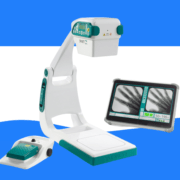What Are Ultrasound Machines? Your Ultimate Guide
As experts in medical imaging, we often encounter questions about various imaging technologies. One of the most frequently asked questions is, “What is an ultrasound machine?” In this ultimate guide, we’ll provide you with a comprehensive overview of ultrasound machines and their applications in the medical field. We aim to demystify this essential diagnostic tool and help you better understand its role in modern healthcare.
What is Medical Ultrasound Imaging?
Medical ultrasound imaging, also known as sonography, is a non-invasive diagnostic imaging technique that uses high-frequency sound waves to create images of the body’s internal structures. These images can help physicians diagnose and monitor a wide range of medical conditions, such as:
- Pregnancy
- Heart conditions
- Abnormalities in organs like the liver, kidneys, and gallbladder
Additionally, ultrasound imaging offers real-time visualization, which makes it particularly useful for guiding minimally invasive procedures. With its versatility and safety, ultrasound has become an indispensable tool in modern medicine.
What is the Difference Between Ultrasound and Sonography?
Medical imaging uses “ultrasound” and “sonography” as separate terms with distinct definitions. To clarify the differences between the two, let’s take a closer look:
Ultrasound: The Sound Waves
Ultrasound refers to the high-frequency sound waves that are employed during the imaging process. These sound waves travel through the body, bounce off internal structures, and return as echoes, then are used to create images.
Sonography: The Imaging Process
Sonography, on the other hand, is the technique of utilizing ultrasound sound waves to generate images of the body’s internal structures. In other words, sonography is the practical application of ultrasound technology in medical imaging.
What is the difference between Ultrasound and CT Scan?
Ultrasound and computed tomography (CT) scans are both diagnostic imaging techniques, but they differ in several key ways:
- Technology: Ultrasound uses high-frequency sound waves to create images, while CT scans use X-rays to generate detailed cross-sectional images of the body.
- Invasiveness: Ultrasound is a non-invasive procedure, whereas CT scans may require the injection of contrast material to enhance the visibility of specific structures.
- Radiation Exposure: Ultrasound does not involve ionizing radiation, making it a safer option for pregnant women and young children. CT scans expose patients to a small amount of ionizing radiation.
- Image Clarity: CT scans often provide more detailed images than ultrasounds, particularly for bony structures and dense tissues. However, ultrasound is superior for imaging soft tissues and fluid-filled structures.
 How Does an Ultrasound Machine Work?
How Does an Ultrasound Machine Work?
When you ask, “What is an ultrasound machine,” it’s understandable you’d like to know more. Here’s what you need to know about how these devices work.
An ultrasound machine emits high-frequency sound waves through a handheld device called a transducer. These sound waves travel through the body and bounce back when they encounter different tissues, such as organs, blood vessels, or bones. The transducer then detects the returning echoes, which send the information to the machine’s central processing unit (CPU).
The CPU processes this information, considering factors like the depth and density of the tissues encountered. It interprets the data and generates an image based on the intensity and timing of the returning echoes. Medical personnel can view the body’s internal structures on a screen as soon as it produces the image. They can make knowledgeable decisions regarding patient treatment based on the image. With continuous advancements in technology, ultrasound imaging has become an indispensable tool in modern medicine.
What is Inside an Ultrasound Machine?
An ultrasound machine consists of several vital components that work together to produce accurate and detailed images:
- Transducer: This handheld device emits and receives sound waves, which is crucial in imaging.
- Central Processing Unit (CPU): The CPU processes the data received from the transducer and generates images based on the interpreted information.
- Display: The display shows the real-time images generated by the CPU, allowing healthcare professionals to analyze and interpret the results.
- Control Knobs: These knobs allow users to adjust various settings on the ultrasound machine, such as image brightness and contrast.
- Keyboard: The keyboard lets users input patient information and add annotations to the ultrasound images.
- Printer: A printer allows users to create hard copies of the ultrasound images for documentation or to share with patients and other healthcare providers.
Upgrade Your Ultrasound with ImagPros!
Exploring Various Types of Ultrasound Machines
Understanding the answer to “What is an ultrasound machine?” includes learning about the different options. Ultrasound machines come in various forms, each tailored for specific diagnostic purposes and imaging requirements. Some of the most common types include:
3D Ultrasound Imaging
3D ultrasound technology enables the capture of three-dimensional images of the body’s internal structures. These images offer more detail and a realistic view than traditional two-dimensional ultrasounds, allowing physicians to visualize and diagnose certain conditions better.
Doppler Ultrasound
Doppler ultrasound focuses on assessing blood flow within the body. This technique is especially useful for diagnosing conditions related to blood circulation, such as deep vein thrombosis, arterial occlusions, and heart valve abnormalities.
Portable Ultrasound Machines
Portable or handheld ultrasound machines are compact, lightweight, and designed for various clinical settings, including ambulances, emergency rooms, and remote locations. These devices provide a convenient imaging solution when a full-size ultrasound machine is not available or practical.
High-intensity Focused Ultrasound (HIFU)
High-intensity focused ultrasound machines use high-energy sound waves to target and destroy specific tissue areas without damaging the surrounding healthy tissue. They primarily use HIFU in cancer treatments, such as prostate cancer or uterine fibroids, as well as certain cosmetic procedures.
Echocardiography
Echocardiography is a specialized type of ultrasound that focuses on imaging the heart and its surrounding structures. This technique helps physicians evaluate heart function, identify heart defects, and assess the overall health of the cardiovascular system.
Each ultrasound machine serves a unique purpose, catering to the diverse needs of medical professionals and patients alike. As technology continues to advance, new and improved ultrasound equipment will undoubtedly emerge to enhance diagnostic capabilities further.
Final Thoughts
Ultrasound machines are crucial in medical imaging, offering versatile and invaluable diagnostic tools. We trust this guide has provided you with a deeper understanding of ultrasound technology and its various applications. If you have any additional questions or wish to explore our selection of ultrasound machines further, contact ImagPros at in**@******os.com or call 248-951-9020.
Experience ImagPros Ultrasound Excellence Today!



 How Does an Ultrasound Machine Work?
How Does an Ultrasound Machine Work?















